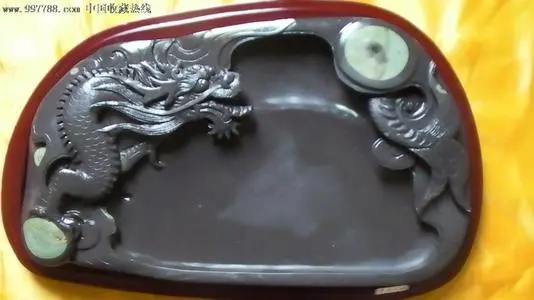In ancient China, intellectuals were usually capable of both writing and drawing. Writing brush, ink, paper and inkstone were essential tools for them, and they were often called the “Four Treasures of the Study 文房四寶 (wén fáng sì bǎo)”. The name “Four Treasures of the Study” originated from the Southern and Northern Dynasties (420-589 AD), and “文房 wén fáng” specifically refers to the study room of intellectuals. Because writing brush, ink, paper, and inkstone are commonly used in the study room, they are hailed as the “Four Treasures of the Study”. In addition to the four treasures, there are pen holders, pen washes, paperweights, stamps, etc., which are also essential items in the study room.

The writing brush is a unique writing and painting tool in ancient China. Brushes are generally made of animal hair. Rabbit hair was first used. Later, people also used animal hair such as sheep, ferrets, wolves, chickens, and rats. According to the “Four Books of the Study” by Su YiJian of the Song Dynasty. Ancients also used human hair or beard to make brushes. The barrel of a brush is usually made of bamboo or other materials. The pen tip is round and pointed, with various lengths and sizes, which are used for different traditional writing and drawing needs. After archaeological discoveries, writing brushes first appeared in the Warring States Period, but since it was too long ago, most of the written work are no longer available.

(Source: https://www.zcool.com.cn/work/ZMzM5NjAyMjA=.html)
Ink is a black material used in calligraphy and painting. It was born in the same era as the writing brush. There were ink marks on the oracle bone inscriptions of the Yin and Shang era, but the ink at that time was only a kind of natural graphite. China’s artificial ink originated in the Warring States Period. Judging from the bamboo and wood slips unearthed at that time, the ink treatment technique was very mature at that time. In the Han Dynasty, with the expansion of the scale of ink making, the scale of ink making workshops became larger and larger. Wei Dan, the calligrapher of the Three Kingdoms period, is the earliest master ink maker recorded in China. Over time, after the Han and Wei Dynasties, ink-making technology became more and more developed, and Huizhou (Anhui province) became the national ink-making center in the Song Dynasty. The “Hui Ink” produced here is famous all over the world, and the famous ink producers Hu Kaiwen and Cao Sugong are still famous.

(Source: https://img.zcool.cn/community/01c94f56ed14a76ac7257d20d4bfcb.jpg@1280w_1l_2o_100sh.jpg)
In ancient times, there was no paper. People often carved or wrote characters on tortoise shells, animal bones, bamboo slices, or silk. Papermaking was invented in the Western Han Dynasty, and Cai Lun’s improvement to papermaking during the Eastern Han Dynasty opened up broad prospects for the development of China’s paper industry. After the Song Dynasty, papermaking technology has improved gradually, with more and more paper varieties and better quality. The most famous one is Xuan paper, which is named after being produced in ancient Xuanzhou (now Xuancheng, Anhui) and has a history of more than a thousand years. Xuan paper has a thin texture, tough cotton, white color, and well-knit. It is resistant to aging, has strong tensile force, and is not easy to change color. It is known as the “thousand-year-old paper”.

The inkstone, also known as Mr. Polish, is the oldest one of the four treasures of the study. It is an indispensable tool for ink grinding. Inkstone is generally made of stones or wear-resistant materials. The exact age of the inkstone is no longer available for examination. However, archaeological data records that people in the Neolithic Age had tools similar to inkstone. During the Tang Dynasty, inkstone-making technology made great progress. Stone inkstone appeared, and famous inkstones such as Duan inkstone and She inkstone appeared in the world. In the Qing Dynasty, the inkstone was gradually crafted. People carved various patterns on the inkstone. Since then, besides the practicality, the inkstone has the value of collection and appreciation.

References:
[1] 張修堯.淺談毛筆的分類.美術教育研究:美術教育研究2010-09-20:1
[2] 筆墨紙硯—格式與想像.廣東美術館. http://www.gdmoa.org/Public_Education/Lecture/201806/t20180629_15387.shtml
[3] 宣紙的種類.https://www.kemaowang.org.cn/n/68230.html
[4] 硯說|硯盞墨香敘時光——歙硯.https://zhuanlan.zhihu.com/p/27367406
